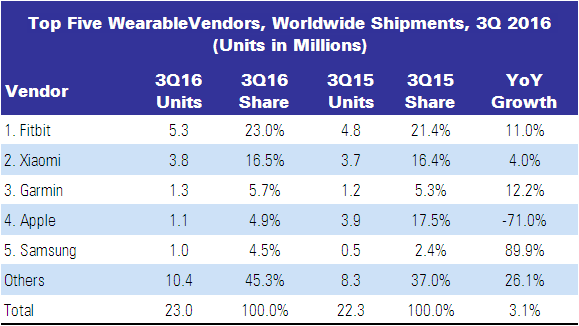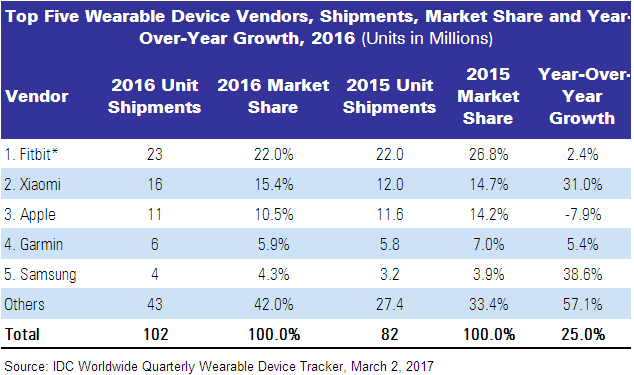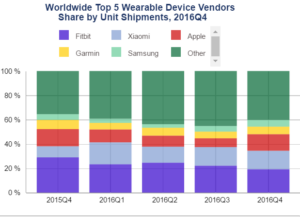According to the IDC Worldwide Quarterly Wearable Device Tracker, shipments of wearable devices reached 33.9 million units in the last quarter of 2016, growing 16.9% year-over-year. This represented an all-time high for the wearables market.
Shipments for 2016 grew 25% due to new vendors entered the market and existing vendors upgrading their products. At the end of 2016, 102.4 million devices shipped.
The wearables market was originally split between devices that could run third party apps and other devices that were more basic and were not capable of loading third-party apps. However, in the past few months, two major platforms, WatchOS and Android Wear, have been introduced that mainly focus on fitness and health applications, and IDC sees this as a move in the right direction.
Ramon Llamas, research manager for IDC’s wearables team believes that health and fitness remains a major focus, but once these devices become connected to a mobile network, we can expect unique applications and communications capabilities to become available.
Besides the main five vendors, new entrants include Fossil, BBK and Li-Ning.
Besides wrist wearables there are ear “hearables” and sensor-laden clothing devices, both of which surpassed 1% of all shipments in the fourth quarter of 2016, with numbers expected to increase in 2017.


Vendor Highlights
Fitbit maintained its dominance, holding the top position for both the quarter and the year. However, the company also faced one of its largest declines ever as it remained heavily focused on the U.S., a market that is quickly approaching saturation for fitness trackers. Though the company has grown in other parts of the world, it also remained challenged as low-cost competitors eat away at its market share.
Xiaomi‘s relentless growth helped to close the gap between itself and the top vendor. Like its other product lines, the company has stuck with a low-cost strategy and has slowly tried to move up in terms of pricing by introducing new devices with heart rate monitoring and a slightly higher selling price. However, Xiaomi still lacks the expertise and brand recognition to expand beyond its native borders in China.
Apple Watch Series 1 and Series 2 proved to be a ‘magnificent success’ for the company, IDC said, as it was the company’s best quarter ever in the wearables market. The lower entry price point and the inclusion of GPS on the Series 2 along with a completely revamped user interface have helped the company grow its presence. Apple is one of the few companies that has been able to quickly refocus its watch to gain traction in the consumer market and has also been ‘leading the charge’ on introducing the smartwatch category to the commercial segment.
Garmin experienced a slight decline of 4.0% in 4Q16. However, the company did manage to significantly raise its average selling price (ASP) to $258 in the fourth quarter from under $200 last year. Garmin caters to a more dedicated fitness audience and this has worked well as many of its users began to graduate from simpler fitness trackers to more sophisticated and expensive sport watches like those offered in the Fenix line. The new Fenix 5 announced at CES 2017 also shows promise as the new smaller size will help the device appeal to a broader audience.
Samsung rounded out the top five with the launch of two new models (Gear S3 Classic and Frontier) and remains the only major company offering cellular-enabled wearables. LTE connectivity has been a key differentiator for Samsung’s watches as it has helped decouple them from smartphones, but more importantly it has opened up a new channel (telcos) to help promote the Samsung watches. Outside of watches, Samsung’s portfolio also includes the Gear Fit 2 and the Icon X, though without any smartphone bundles, volumes for these wearables were lower than expected.



